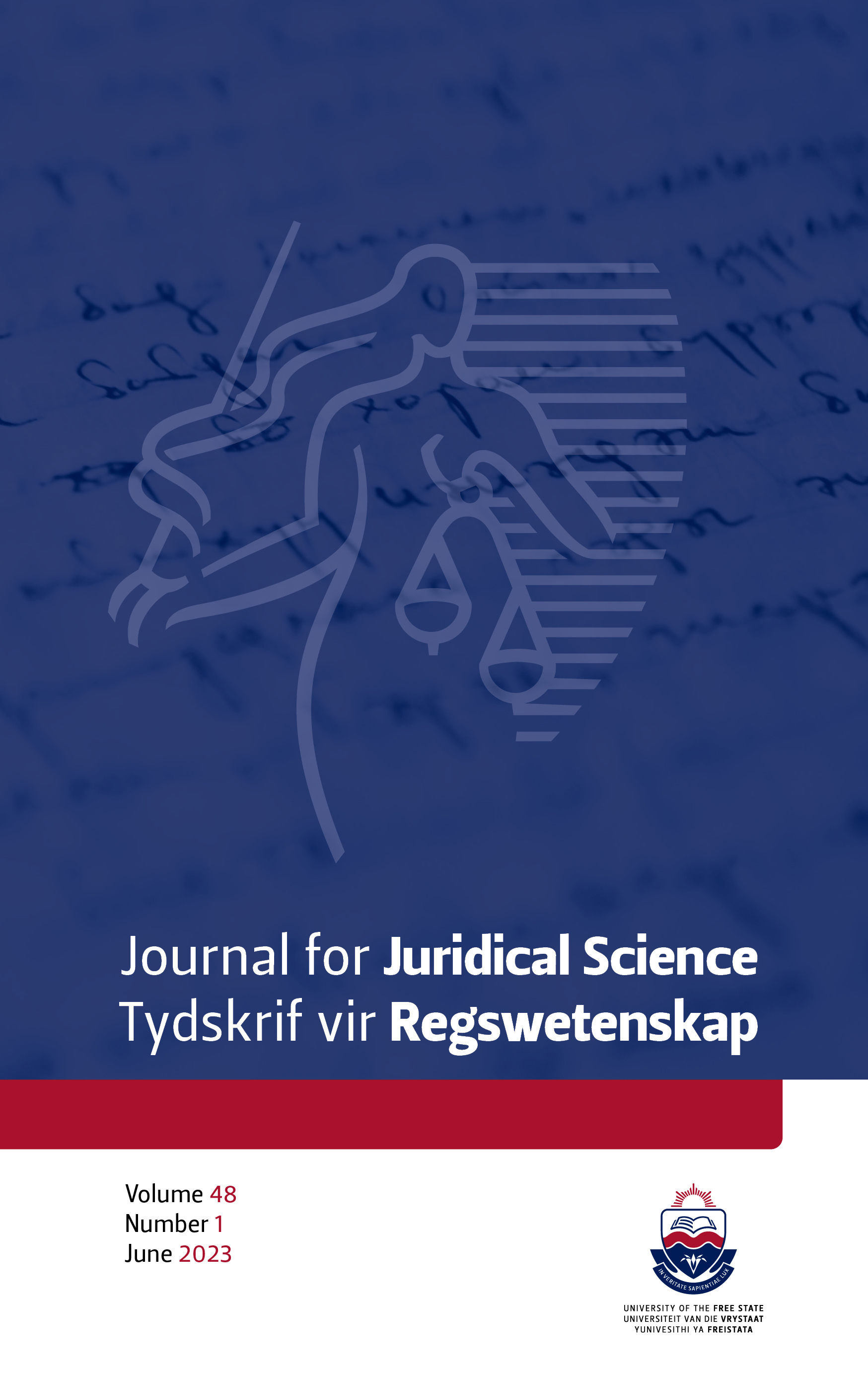Evaluating the Role of Judicial Oversight in the Context of the Post-2018 Emolument Attachment Order Legal Frame
Revisiting University of Stellenbosch Legal Aid Clinic V Minister of Justice 2015 5 Sa 221 (WCC)
DOI:
https://doi.org/10.38140/jjs.v48i1.7344Abstract
Historically, mechanisms facilitating civil debt collection and its broader discipline of civil procedure have been an unpopular legal research area, not only in South Africa, but also abroad.[1] In recent years, one civil debt collection mechanism has, however, attracted some academic attention.[2] This attention has resulted from relatively rapid legal developments to counteract widespread debtor exploitation resulting from systemic abuses.[3] The emolument attachment order (hereafter, “EAO”) mechanism, sometimes also referred to as garnishee orders,[4] functions as a civil debt collection instrument, usually following the granting of a default judgment,[5] where the debtors are judged to be legally liable to their creditor.[6] Through the application of EAOs, debtors’ property, specifically their wages, are exposed to execution, in order to satisfy the creditors’ expectations of performance. In this manner, a portion of workers’ wages are withheld from them by the debtors’ employers (the garnishees) after being legally requested or reserved by creditors. The EAO mechanism is a popular debt-collection instrument affecting the lives of potentially millions of people.[7] Creditors favour debt collection through the EAO mechanism, as it offers a relatively convenient and secure form of debt enforcement.[8]
[1] De Vos 2002:236-237.
[2] See, for example, Coetzee & Van Sittert 2018; Van der Merwe 2019.
[3] Van der Merwe 2019:87-90.
[4] There is a slight, but important difference between garnishee orders, a term used to describe an order that empowers the creditor to attach any debt owed to the debtor by any third party, and EAOs, which are specific forms of garnishee orders applicable to the employer-employee relationship. See Van der Merwe 2019:78.
[5] Van der Merwe 2008:78.
[6] The definition of EAOs is apparent from their function, which is explained in sec. 65J(1)(b) of the Magistrates’ Courts Act 32/1944.
[7] As far as the author can ascertain, there are no statistics available on the exact number of EAOs currently in circulation. Haupt et al. 2008:85-104 experienced a similar challenge and relied on estimates to provide some indication of the extent of EAO use at the time. The author’s estimation of the number of lives affected by EAOs, including extended family members, is aligned with available data regarding the extreme scale of South African indebtedness (see, for example, Coetzee & Van Sittert 2018:110) and earlier indications of the prevalence of EAOs in circulation. See, for example, Van der Merwe 2019:80 at fn. 26, referring to an audit of a portion of the 1,75 million EAOs in existence in 2007.
[8] South African labour laws are relatively protective of employees and EAO debtors are specifically safeguarded from employer retaliation as a result of EAO deductions. See Smit & Van Eck 2010:47, 65-66. In terms of sec. 185 of the Labour Relations Act 66/1995, every employee has the right not to be unfairly dismissed.
Downloads
References
COETZEE H & VAN SITTERT C
Reflections on recent developments regarding wage garnishment in South Africa. International Journal of Private Law 9(1/2):107-123.
DE VOS WL
South African civil procedural law in historical and social context. Stellenbosch Law Review 13(2):236-251.
GOVERNMENT OF THE UNITED KINGDOM
Make debt deductions from an employee’s pay. https://www.gov.uk/debt-payments-from-your-wages/check-debt-amount (accessed on 17 August 2022).
HAHLO H & KAHN E
The Union of South Africa: The development of its laws and constitution. London: Stevens & Sons.
HAUPT F, COETZEE H, DE VILLIERS D & FOUCHÉ J
The incidence of and the undesirable practices relating to garnishee orders in South Africa. https://www.ncr.org.za/documents/pages/research-reports/oct08/
GARNISHEE-ORDERS-STUDY-REPORT.pdf (accessed on 17 August 2022).
HM COURTS & TRIBUNALS SERVICE
EX323: Attachment of Earnings. https://assets.publishing.service.gov.uk/
government/uploads/system/uploads/attachment_data/file/865024/ex323-eng.pdf (accessed on 17 August 2022).
JAMES D
Money from nothing: Indebtedness and aspiration in South Africa. Johannesburg: Wits University Press.
JUSTIA
Nebraska Revised Statutes Chapter 25 – Courts; Civil Procedure 25-1056(2). https://law.justia.com/codes/nebraska/2019/chapter-25/statute-25-1056/ (accessed on 17 August 2022).
KHULUVHE M
Fact sheet: Adult illiteracy in South Africa. https://www.dhet.gov.za/Planning
%20Monitoring%20and%20Evaluation%20Coordination/Fact%20Sheet%20on%20Adult%20Illiteracy%20in%20South%20Africa%20-%20March%202021.pdf (accessed on 17 August 2022).
MULLEN F
Fifty years after the Consumer Credit Protection Act: The high price of wage garnishments. Mitchell Hamline Law Review 45(1):191-236.
NORTH DAKOTA STATE GOVERNMENT
North Dakota Century Code Title 32-09. https://www.legis.nd.gov/cencode/
t32c09-1.pdf#nameddest=32-09p1-20 (accessed on 17 August 2022).
PARLIAMENTARY MONITORING GROUP
Courts of Law Amendment Bill (B8-2016) Summary and analysis. https://pmg.org.za/bill/643/ (accessed on 17 August 2022).
PEARSON G, STOOP PN & KELLY-LOUW M
Balancing responsibilities – Financial literacy. Potchefstroom Electronic Law Journal 20(1):1-55.
SCHRATEN J
Credit and debt in an unequal society: Establishing a consumer credit market in South Africa. New York: Berghahn Book.
SMIT P & VAN ECK BPS
International perspectives on South Africa’s unfair dismissal law. The Comparative and International Law Journal of Southern Africa 43(1):46-67.
VAN DER MERWE S
Failure to discharge: A discussion of the insufficient legal recourse afforded to judgment debtors in the South African context. Journal of Juridical Science Special Issue:71-86.
Traversing the South African emolument attachment order legal landscape post-2016: Quo vadis? Stellenbosch Law Review 30(1):77-96.
WILLBORN S
Wage garnishment: Efficiency, fairness, and the Uniform Act. Seton Hall Law Review 49(4):847-870.
WILSON M, FORD J & HUGHES M
Recovering debt: The effectiveness of attachment of earnings? Civil Justice Quarterly 11(Oct):363-383.
WOOD D
Wage garnishment under the Consumer Credit Protection Act: An examination of the effects on existing state law. William and Mary Law Review 12(2):357-395.
##submission.downloads##
Published
Issue
Section
License
Copyright (c) 2023 Stephan van der Merwe

This work is licensed under a Creative Commons Attribution 4.0 International License.




